After the tour around Bago station, it had been suggested that I might like to return to Yangon by train, a suggestion I readily accepted. I'd travelled on the line from Yangon to Bago back in 2012, as described in the post here. Re-reading this post I was reminded that, since then, my understanding of railway practices in Myanmar has improved but, as I wrote in the post Myanmar, Railways and Jan, "In Myanmar, there always seem to be more questions than answers".
Train 32 from Naypyitaw was due, they said, at 15:00. They also suggested that my photographic opportunities might be better in an Ordinary Class coach, where all the windows were sure to be fully open, rather than an Upper Class coach. I agreed with their reasoning and a ticket was issued. Then they said the train was 15 minutes late and it actually arrived about 15:20.

The Railway at Bago, 9th May 2018: Train 32 from Naypyitaw arriving at Bago.
The useful rail travel website 'The Man in Seat 61' gave the following timings:-
| Train number 32: Naypyitaw > Yangon | Arrive | Depart |
| Naypyitaw | 08:00 | |
| Taungoo | 10:56 | 10:59 |
| Bago | 15:20 | 15:23 |
| Yangon | 17:00 |
I was embarrassed that the railway staff insisted on shooing passengers into other seats so as to give me a bench seat for two facing the direction of travel.
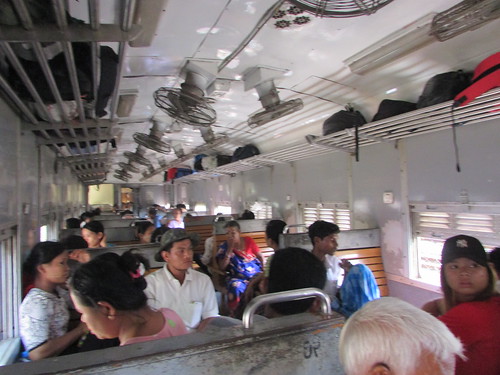
Bago - Yangon by train 9th May 2018: General view of my Ordinary Class coach.
We left about 15:23 and slowly threaded our way through the undulating trackwork leaving the station, past the informal refuse tip which is, sadly, an all-too-common feature in Myanmar.
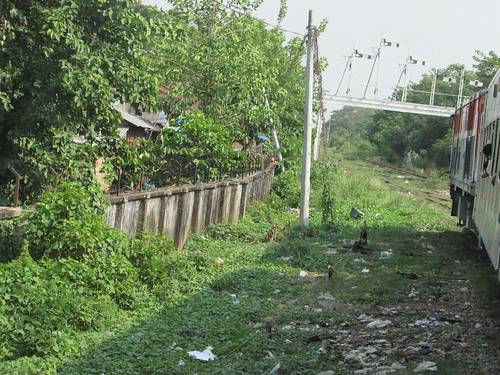
Bago - Yangon by train 9th May 2018: The splendid semaphore signal gantry controlled by Bago South Signal Box. The Up Outer signal is just visible in the distance.
Most stations in Myanmar have a 'running-in board' at each end of the platform area with the name displayed in both Myanmar language script and 'Romanised' form which I relied on to identify our progress. The Romanised spelling can be quite variable ('Bago' is often rendered as 'Pegu', for instance) as Westerners struggled to cope with the subtleties of pronunciation.
I've made frequent use of the Wikipedia article List of railway stations in Myanmar. It's very useful but perhaps not infallible. The list below, showing station names and distances from Yangon in miles, is taken from this article. I've added (in brackets) two stations not shown in the Wikipedia article.
Bago 46.5
Payathonzu 42.5
Ta Wa 38.25
Kyauk Tan 34
Htone Gyi 30.25
Kawt Che 27
(Dabein)
(Lay Daung Kan)
Ywar Thar Gyi 12.75
Togyaunggalay 7.25
Nga Moe Yeik 5.25
Thin Gan Gyun 4.5
Hnin Si Kone 4
Mahlwagon 2.25
Pazundaung 1
Yangon 0
My photographs were largely limited to the Down side (on the left travelling towards Yangon) but I managed some sort of pictorial record of most stations. We cracked along at what, for a Burmese train, was a very good speed on what is now Continuous Welded Rail, giving a much better experience compared with my trip in the opposite direction in 2012 (described here).
The facilities at Payathonzu (at least on 'my' side) were fairly basic but the shrubs on the platform were nonetheless carefully surrounded by whitewashed stones.

Payathonzu station. The concrete post supports an overhead cable route.
Approaching Ta Wa, there was a long refuge siding for freight trains - one of a number on this line in both directions. The station itself was well cared-for.
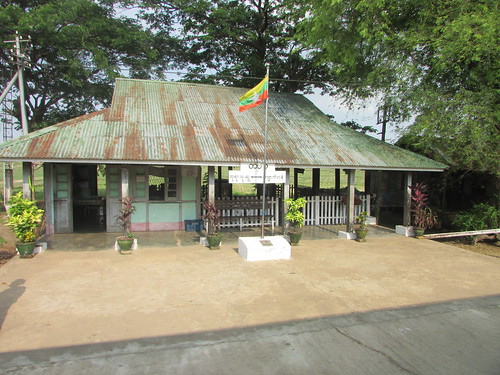
Bago - Yangon by train 9th May 2018: Ta Wa station
Approaching Kyauk Tan, there was another refuge siding. These sidings invariably look as if they have been disused for a long time but, occasionally, a train can be seen. At Kyauk Tan, DF1311 with a freight train was standing in the refuge siding waiting for a 'margin' to proceed further. The motorised trap points and position light ground signal definitely looked derelict so I presume that the main line points are now worked manually with movements controlled by handsignal. The station itself was larger than Ta Wa, with an overall roof covering the broad platform.
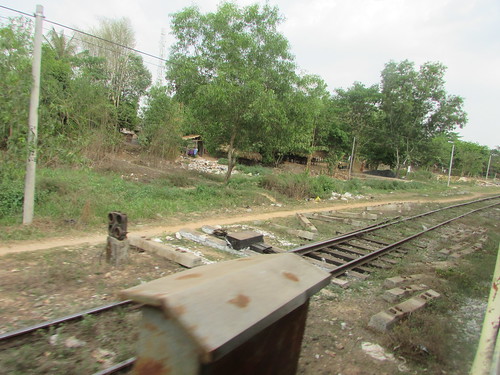
Bago - Yangon by train 9th May 2018: Refuge siding at Kyauk Tan.
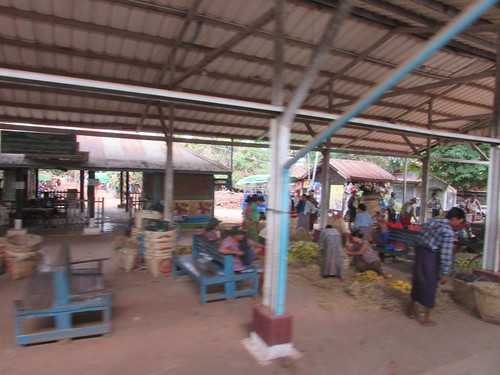
Bago - Yangon by train 9th May 2018: Kyauk Tan station.
The next station, Ton Gyi, also had a similar refuge siding. Although the position light ground signal was out-of-service, this time the motorised trap points were at least in the 'run-off' position, providing 'flank protection' to my train, as intended. Here, the rather-portly Station Master was on the platform, displaying a green flag to my train.
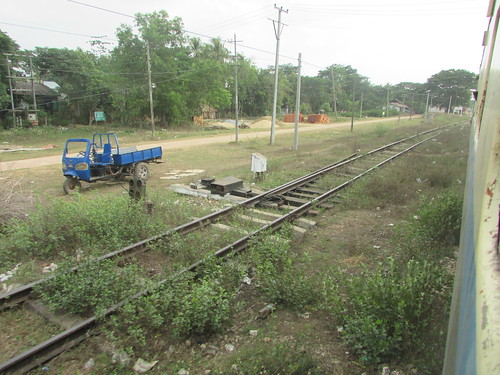
Bago - Yangon by train 9th May 2018: Refuge siding at Ton Gyi.

Bago - Yangon by train 9th May 2018: Ton Gyi station.
I failed to see Kawt Che station altogether, instead securing this shot of an overhead cable joint.
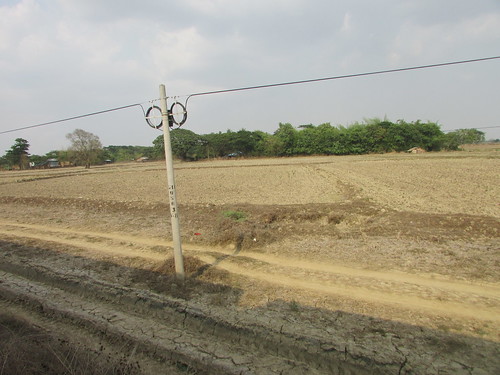
Bago - Yangon by train 9th May 2018: Concrete post supporting overhead cable, showing cable joint.
Dabein also had a refuge siding, occupied by a stabled Railway Gang Car (ED/RGC.84) used for track maintenance work. This was coupled to a flat car fitted with a crane.
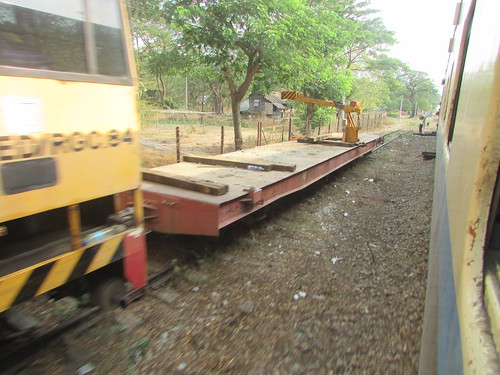
Bago - Yangon by train 9th May 2018: Approaching Dabein station with Railway Gang Car ED/RGC.84 coupled to flat car with crane stabled in refuge siding. Note handsignalman at white marker board used in exchange of Paper Line Clear Forms.
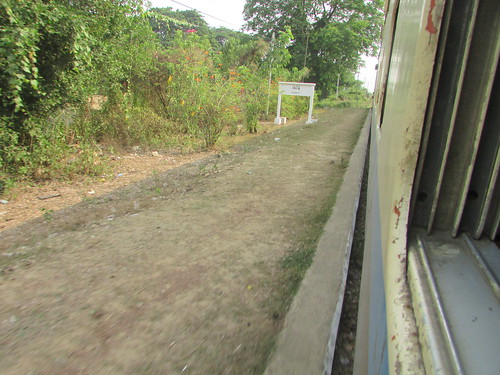
Bago - Yangon by train 9th May 2018: Dabein station, showing bi-lingual nameboard at Yangon end of Down platform.
From time to time, we passed 3-aspect colour light signals, apparently defunct. There were two approaching Lay Duang Kan. A few seconds after passing the second 'dark' colour light, we passed an upper-quadrant semaphore signal which, in an unusual reversal of normal practice, appeared to have replaced the colour light signal.
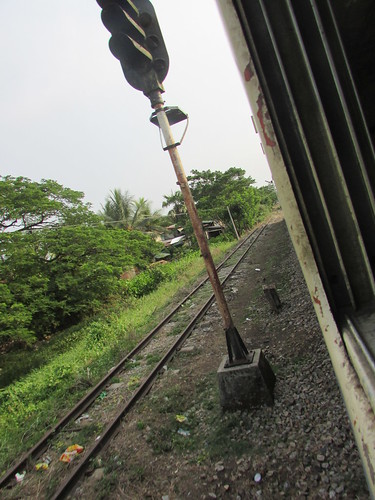
Bago - Yangon by train 9th May 2018: 3-aspect colour light signal (apparently not in use) approaching Lay Duang Kan.
The semaphore signal was interesting - a substantial channel-section post provided with a ladder mounting a tapering, corrugated signal arm fitted with a 3-position spectacle (without coloured glasses, of course), with the arm raised 45 degrees.

Bago - Yangon by train 9th May 2018: Channel-section post upper quadrant stop signal approaching Lay Duang Kan.
Once again, a refuge siding was provided on the approach to the station, with trap points in the siding and a trailing point in the main line, both provided with electric point machines. I couldn't determine whether they were still functional or not but the white paint on the ballast around the main line point machine gave some hope. A handsignalman with a green flag was standing at the nearby white marker board.
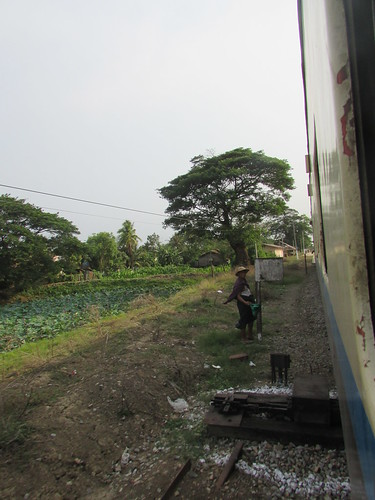
Bago - Yangon by train 9th May 2018: Point machine, Handsignalman and white marker board (used in exchange of Paper Line Clear Forms) approaching Lay Duang Kan.

Bago - Yangon by train 9th May 2018: Lay Duang Kan station.
Leaving Lay Duang Kan there was a disused version of the 3-position semaphore I'd seen as we approached the station. The spectacle was still intact but the arm had been removed by taking out the four securing bolts. A rectangular white board with a smaller black rectangle had been fixed to the post which I think denotes 'end of station limits'.
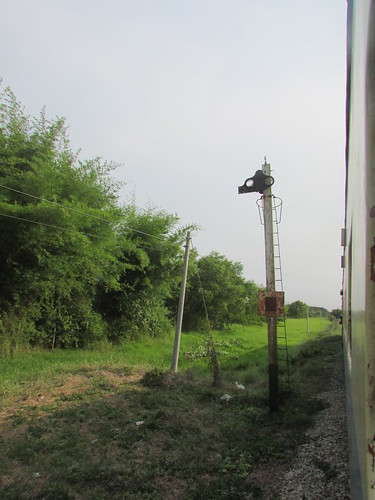
Bago - Yangon by train 9th May 2018: Disused semaphore signal leaving Lay Duang Kan station.
Approaching Ywa Tha Gyi station, another handsignalman displayed a green flag. Beyond the station, we passed a small group of sidings with a few SMBV wagons loaded with treated timbers.
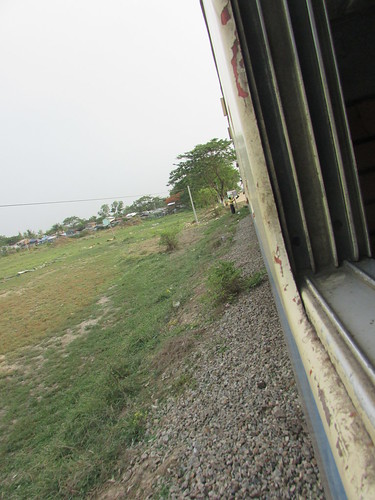
Bago - Yangon by train 9th May 2018: Approaching Ywa Tha Gyi station: Handsignalman and white marker board (used in exchange of Paper Line Clear Forms).
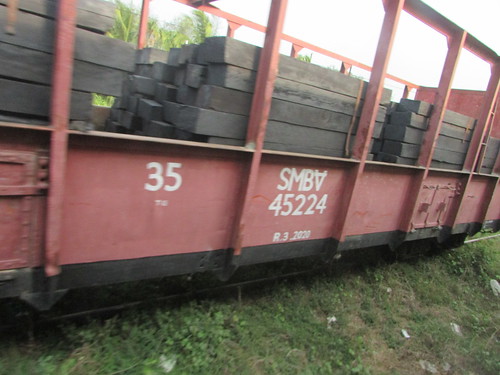
Bago - Yangon by train 9th May 2018: Sidings at Ywa Tha Gyi, showing SMBV (with brake removed) loaded with permanent way timbers.
The scenery was now becoming more urban. I saw a number of contractors, wearing hard hats and high-visibility jackets, presumably involved in modernisation work on the line. When we passed a fixed, semaphore distant signal, I realised that we were approaching Togyaunggalay (spelling varies) and the next signal was a 3-aspect colour light. The picture below also shows one of the very many flooded fields adjacent to the railway around Yangon where farmers work, waist deep in water, tending vegetables to satisfy the city's demand. Beyond the signal, we passed a ballast train, headed by Bo-Bo-Bo locomotive DF.1610 waiting in sidings.
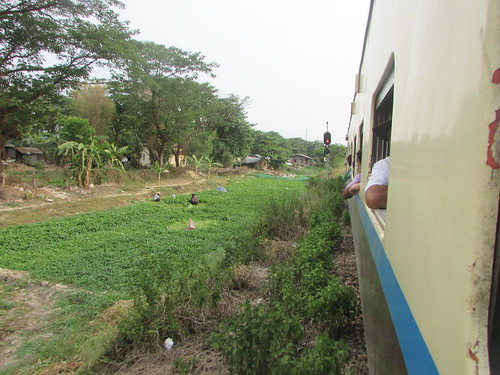
Bago - Yangon by train 9th May 2018: 3-aspect colour light signal (16L) with position light subsidiary (41L) approaching Togyaunggalay.
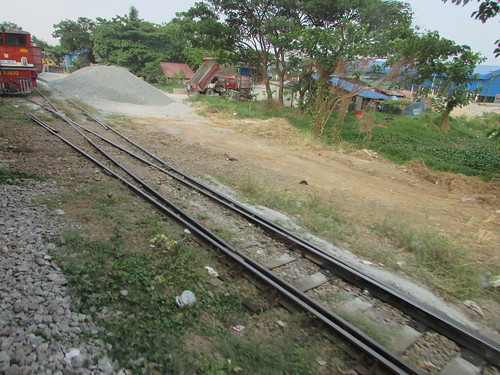
Bago - Yangon by train 9th May 2018: Passing ballast train of MHLV wagons (brakes removed) in sidings approaching Togyaunggalay, showing DF.1610. Note tipper lorry, having discharged a load of ballast.
My train stopped for a couple of minutes at Togyaunggalay, which is the limit of suburban workings from Yangon on the main line. The picture below shows the power signal box which I believe uses Korean signalling equipment (like Insein). The picture below shows the radio antenna used for train despatching on the left and incoming overhead 3-phase supply terminated on a trellis-like frame on the right. There will be a step-down transformer behind the wall feeding the rather unkempt low-voltage wiring visible which is distributed around the station via the vertical pole (made from an old rail) on the platform side of the wall.
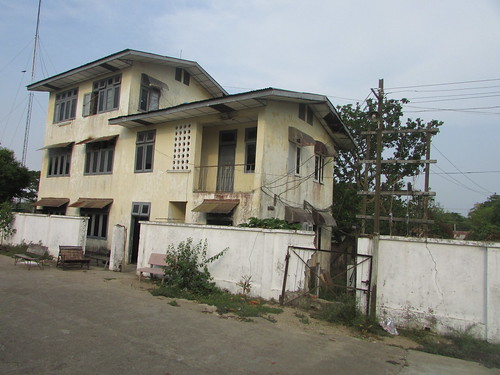
Bago - Yangon by train 9th May 2018: Togyaunggalay signal box. Note radio antenna on left and incoming overhead 3-phase electricity supply terminated on frame on the right.

Bago - Yangon by train 9th May 2018: Togyaunggalay station.
In the bay platform, Bo-Bo-Bo DF.1221 stood at the head of a well-loaded suburban train, which would presumably follow us into Yangon, stopping at All Stations. Leaving Togyaunggalay, we passed over the level crossing on Pyi Htaung Su Main Road then, following a scissors crossover, the branch to Thilawa deverged to the left.

Bago - Yangon by train 9th May 2018: Togyaunggalay station, with Bo-Bo-Bo DF.1221 on suburban train in bay platform on left.
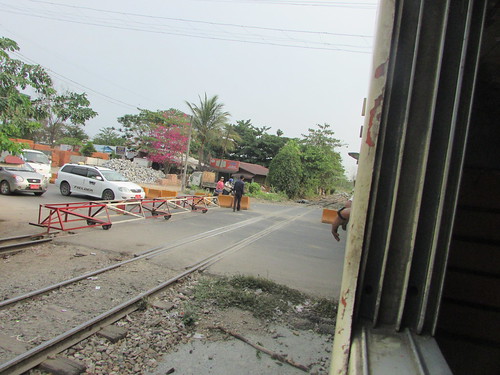
Bago - Yangon by train 9th May 2018: Leaving Togyaunggalay station, passing over Pyi Htaung Su Main Road level crossing. The scissors crossover before the Thilawa branch diverges is just visible.
We crossed Pazundaung Creek via two spans of steel truss bridge and ran through Nga Moe Yiek station, where there were lots of passengers waiting (presumably for the train we'd seen in the bay at Togyaunggalay).
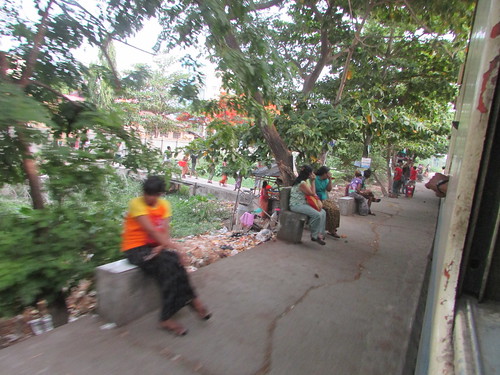
Bago - Yangon by train 9th May 2018: Nga Moe Yiek station.
The next station, Thin Gan Gyun station, was also busy. Here, the numbering of the 2-aspect colour light we passed (21A) and the design of the trackside building visible in the background suggested that the station has its own signal box. Enquiries are continuing.
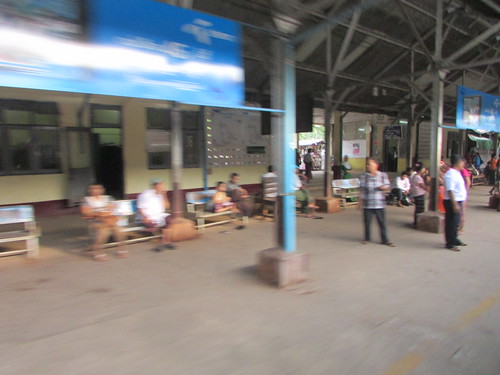
Bago - Yangon by train 9th May 2018: Thin Gan Gyun station.
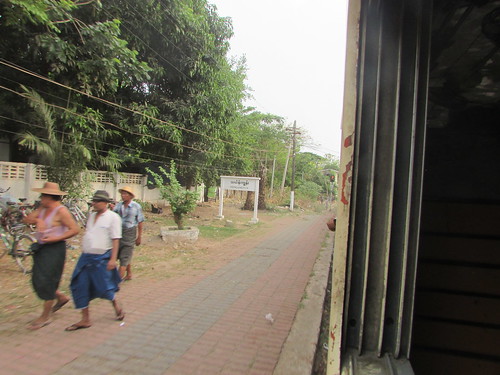
Bago - Yangon by train 9th May 2018: Passing Thin Gan Gyun station showing 2-aspect colour light signal 21A.
Hnin Si Kone also had waiting passengers.

Bago - Yangon by train 9th May 2018: Hnin Si Kone station.
About 1.5 miles after passing through Hnin Si Kone, the Circle Line appeared on our right and ran parallel through Mahlwagon and Pazundaung to give a 4-track section towards Yangon as shown in the diagram below. Beyond Pazundaung a complex ‘flat crossing’ junction switches Circle Line trains across the Up and Down Bago main lines as they pass from or to the local lines.

Myanma Railways: Simplified line diagram Mahlwagon - Pazundaung.
Click for larger version
There are a number of posts which describe the interesting arrangements between Mahlwagon, Pazundaung and Yangon Central Station. For more information, it may be helpful to look at the index post here.
On this trip from Bago, I did notice some of the modernisation work in progress and took pictures of a couple of Japanese colour light signals which have not yet replaced the earlier arrangements.

Bago - Yangon by train 9th May 2018: Approaching Yangon Central on Down Main showing L: Westinghouse Signal R141/R139, R: Replacement signal R141/R139, not yet commissioned.
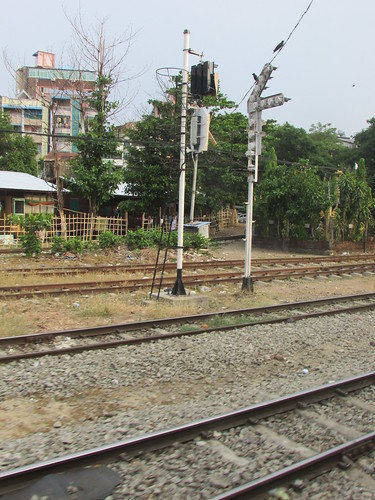
Bago - Yangon by train 9th May 2018: Approaching Yangon Central on Down Main showing L: Replacement signal, not yet commissioned, R: Existing signal P7 (Siemens).
My train ran into platform 2 at Yangon Central at 17:00 and the locomotive was quickly uncoupled, drew forward and headed for the Depot light engine via platform 1.
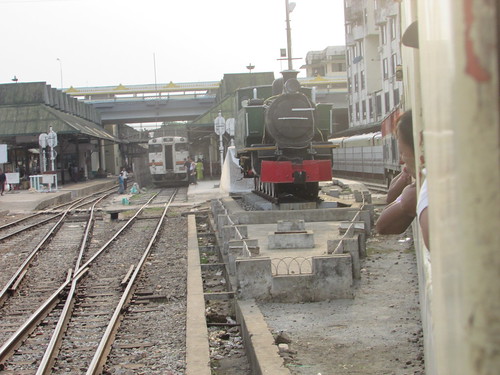
Bago - Yangon by train 9th May 2018: Arriving platform 2, Yangon Central Station.
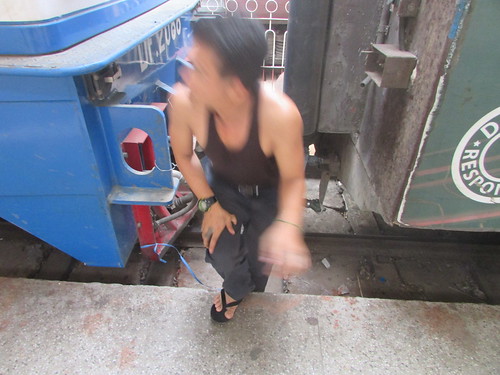
Bago - Yangon by train 9th May 2018: On arrival at Yangon, the locomotive was quickly uncoupled.
Afterwards, by checking the time stamp of my pictures as we passed stations, I was able to make a rough assessment of speed. Our average speed over the first four miles to Payathonzu was about 24 miles per hour, as the driver accelerated the train. The next thirty miles, until our deceleration approaching Togyaunggalay, were reeled off at a consistent 36 miles per hour. We stopped for about two minutes at Togyaunggalay, the limit of main line suburban trains from Yangon, and averaged around 24 miles per hour onwards to our final destination at Yangon Central Station.
Related posts on this website
To find my posts describing Myanma Railways, select label 'Myanma-Railways' or click here. Posts are shown in reverse date-of-posting order.
There's also an Index of my Myanma Railways posts here (but this may not always be quite up-to-date).
This is one of a series of posts describing my 13th visit to Myanmar, only some of which describe railways.
The post Travelling again is the first post in the series.
Clicking on the 'Next report' link will show the post describing the next events. In this way, you may read about the trip in sequence.
Alternately, clicking on the 'All my Burma-2018 reports' link displays all the posts on this trip in reverse date-of-posting order.
All my Burma-2018 reports.
My pictures
Where necessary, clicking on an image above will display an 'uncropped' view or, alternately, pictures may be selected, viewed or downloaded, in various sizes, from the albums shown below.
Albums with pictures of the line from Yangon to Bago (including Bago itself) are listed:-
Yangon to Bago by Train (earlier pictures).
Bago Station (earlier pictures).
The Railway at Bago, 9th May 2018.
Bago to Yangon by Train, 9th May 2018.
All my pictures of Myanma Railways are in the collection 'Railways in Burma'. You can find them through the index of individual albums here.
